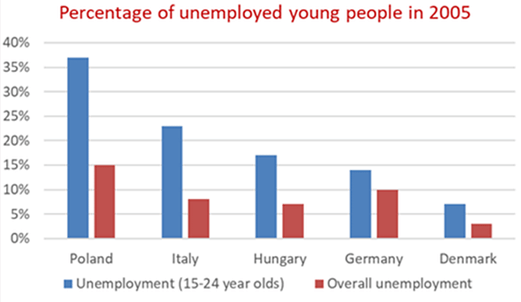5+ The graph below shows the percentage of unemployed people aged between 15 and 24 in five
The graph below shows the percentage of unemployed people aged between 15 and 24 in five European countries in 2005, compared with the overall percentage of unemployment in those countries. Summarise the information by selecting and reporting the main features, and make comparisons where relevant. Write at least 150 words hay nhất giúp bạn có thêm tài liệu tham khảo để viết bài luận bằng Tiếng Anh hay hơn.
- The graph below shows the percentage of unemployed people aged between 15 and 24 in five (mẫu 1)
- The graph below shows the percentage of unemployed people aged between 15 and 24 in five (mẫu 2)
- The graph below shows the percentage of unemployed people aged between 15 and 24 in five (mẫu 3)
- The graph below shows the percentage of unemployed people aged between 15 and 24 in five (mẫu 4)
- The graph below shows the percentage of unemployed people aged between 15 and 24 in five (mẫu 5)
- The graph below shows the percentage of unemployed people aged between 15 and 24 in five (mẫu 6)
- The graph below shows the percentage of unemployed people aged between 15 and 24 in five (mẫu 7)
- The graph below shows the percentage of unemployed people aged between 15 and 24 in five (mẫu 8)
- The graph below shows the percentage of unemployed people aged between 15 and 24 in five (mẫu 9)
5+ The graph below shows the percentage of unemployed people aged between 15 and 24 in five
Đề bài: The graph below shows the percentage of unemployed people aged between 15 and 24 in five European countries in 2005, compared with the overall percentage of unemployment in those countries. Summarise the information by selecting and reporting the main features, and make comparisons where relevant. Write at least 150 words
The graph below shows the percentage of unemployed people aged between 15 and 24 in five - mẫu 1
The provided bar graph illustrates data from five European nations in 2005. It is about the rate of total unemployment as compared to the unemployment of a specific younger age group.
Overall, it is obvious that the rate is substantially greater among the younger generation when compared to global figures.
According to the graph, Poland had the highest total unemployment rate in 2005. 37% of its 15% overall unemployed were between the ages of 15 and 24. Germany was the second most struck by the crisis, but the impact on the younger generation was less severe than in Poland. When compared to the national unemployment rate of 10%, the proportion of the 15-24 age group who were unemployed was little under 15.
When the general unemployment rate in Italy and Hungary was between 6 and 8, the proportion of jobless youngsters aged 15 to 24 years. It was approximately 24 and 17%, respectively, which was higher than in Germany. Denmark was the least hit by the crisis. The proportion of young people unemployed there was over 8%, compared to only 3% in the total unemployment data.
The graph below shows the percentage of unemployed people aged between 15 and 24 in five - mẫu 2
The bar chart depicts the unemployment rates of young individuals aged 15-24 as well as the entire workforce in five European nations in 2005.
In terms of the proportion of unemployed young adults, Denmark had the lowest result (just over 5%). Germany and Hungary had around three times the rate of young unemployment as Denmark. Italy and Poland had the highest unemployment rates, at around 23% and 37%, respectively.
In terms of total unemployment rates, Poland also had the highest result in this category. In Poland, 15% of the workforce was unemployed, but in Germany, 5% fewer individuals were unemployed. Italy and Hungary followed, both with approximately 6-7% total unemployment. In Denmark, the unemployment rate was only about 3%.
In general, the data shows that young unemployment rates were much higher than overall estimates in all of the nations included. Poland was top in both categories, while Denmark was last. Italy and Germany were in the middle, with Hungary representing the overall average.
The graph below shows the percentage of unemployed people aged between 15 and 24 in five - mẫu 3
The given bar chart compares five different countries in terms of the proportion of jobless individuals aged 15 to 24 and the overall unemployment rate in 2005.
Overall, it is notable from the chart that Poland recorded the highest unemployment rates, while Denmark experienced the lowest. Another key observation is that the unemployment rate among the 15-24 age group was higher than that of the total population in all the countries surveyed.
In Poland, over 35% of individuals in the 15-24 age bracket were jobless, more than double the figure for the total population, both of which were by far the highest among the five countries. Italy and Hungary displayed similar trends, albeit with smaller disparities between the two rates. The unemployment rate among 15-24-year-olds in these countries ranged from approximately 18% to 24%, while the overall unemployment rate was around 8%.
Germany showed that just under 15% of those aged 15-24 were unemployed, which exceeded the overall rate by about 5%. Meanwhile, Denmark had the lowest figures, with only 3% of the total population facing unemployment and around 7% of young individuals aged 15-24 being jobless.
The graph below shows the percentage of unemployed people aged between 15 and 24 in five - mẫu 4
The bar graph compares the unemployment rates between the 15 to 24 age group and the total population, in five different nations in Europe in 2005. Overall, the unemployment rate of the young cohort was higher than the overall percentage for all given countries. Additionally, Poland recorded the highest proportion for both categories, whereas Denmark experienced the lowest.
In terms of individuals aged 15 to 24, approximately 36% of Polish youths were jobless, which was significantly higher than Italy and Hungary at roughly 23% and around 16%, respectively. Moreover, the unemployment rate of youngsters in Germany was nearly 15%, while that of Denmark was the lowest result at about 7%.
Turning to the overall unemployment rate, Poland documented a national rate of precisely 15%, followed by Germany at one-tenth. Furthermore, Italy and Hungary exhibited comparable percentage points of around 7%, which was about double that of Denmark.
The graph below shows the percentage of unemployed people aged between 15 and 24 in five - mẫu 5
The graph compares the unemployment rates of individuals aged 15-24 with the overall unemployment rates in five European countries in 2005.
It is evident that the unemployment rate among the 15-24 age group consistently exceeded the overall unemployment rate across all five countries. Notably, Poland recorded the highest figures in both categories.
Specifically, Poland had the highest overall unemployment rate, at around 15%, with a significantly higher youth unemployment rate of 37%. Italy and Hungary had relatively similar overall unemployment rates, at 7% and 8% respectively, but differed in youth unemployment. Italy’s youth unemployment rate was notably higher at 23%, compared to Hungary’s 17%.
Germany and Denmark presented more balanced employment figures between age groups. Germany, with the second-highest overall unemployment rate of 10%, had a youth unemployment rate of 14%, only 4% higher than the general rate. Denmark, however, had the lowest overall unemployment at 3% and the smallest youth unemployment rate at 7%, reflecting the least disparity between the two categories.
The graph below shows the percentage of unemployed people aged between 15 and 24 in five - mẫu 6
The bar chart illustrates the percentage of unemployed people aged between 15 and 24 in five European countries in 2005, compared with the overall unemployment rate in those countries.
Overall, young people aged 15 to 24 faced higher unemployment rates compared to the overall population in all five European countries. Poland had the highest youth unemployment rate, while Denmark had the lowest rates for both youth and overall unemployment.
A closer examination of the chart reveals that Poland had the highest youth unemployment rate, at 38%, while the overall unemployment rate was significantly lower, at 15%. Italy followed, with a youth unemployment rate of 24%, and an overall unemployment rate of 8%. Hungary also exhibited a notable disparity between the youth and overall unemployment rates, with youth unemployment at 17% and overall unemployment at 7%.
In contrast, Germany showed a smaller gap between youth and overall unemployment rates, with 14% youth unemployment and 10% overall unemployment. Denmark had the lowest rates among the five countries, with youth unemployment at 7% and overall unemployment at 4%. Notably, Denmark was the only country where youth unemployment was lower than the European average.
The graph below shows the percentage of unemployed people aged between 15 and 24 in five - mẫu 7
The bar chart provides information about the unemployment rates of young adults aged 15-24 and that of the total workforce in five European countries in the year 2005.
Looking at the proportion of jobless young adults, the lowest figure was recorded in Denmark (just over 5%). Germany and Hungary had approximately three times higher youth unemployment rates compared to Denmark. The highest unemployment rates were observed in Italy and Poland, about 23% and 37% respectively.
As regards the overall unemployment rates, Poland witnessed the highest figure in this category as well. Fifteen percent of the Polish workforce was jobless while 5% fewer people were idle in Germany. Italy and Hungary came next with similar levels of overall unemployment, nearly 6-7%. In comparison, Denmark had only around 3% unemployed people.
In general, what stands out from the chart is that the youth unemployment rates were significantly higher than the overall figures in all the listed countries. Poland ranked the first in both the categories while Denmark came last. Italy and Germany were in the halfway marks with Hungary representing the overall mean.
The graph below shows the percentage of unemployed people aged between 15 and 24 in five - mẫu 8
The provided bar chart compares and contrasts the unemployment rates of young people aged 15 to 24 with the overall unemployment rates in five European countries in 2005. Overall, the data reveals that youth unemployment consistently exceeded the general unemployment rate across all five countries. Poland experienced the highest rates in both categories, while the opposite was true for Denmark.
As illustrated, Poland's youth unemployment rate reached approximately one-third (33%), significantly surpassing its overall unemployment rate of 15%. No other country surveyed had such a substantial gap between youth and general unemployment. In contrast, the rate of Danish young people who did not have a job remained relatively low at just over 5%, with an overall rate of jobless personnel around 2-3%.
Italy, Hungary, and Germany exhibited youth unemployment rates ranking second, third, and fourth, respectively. While Italy and Hungary showed a noticeable difference between the two groups of unemployment, similar to Poland, Germany's rates were more comparable, with the overall proportion of those in between jobs at 10%, only slightly lower than its youth unemployment rate.
The graph below shows the percentage of unemployed people aged between 15 and 24 in five - mẫu 9
The bar chart depicts the percentage of unemployed individuals aged 15 to 24 in five European countries in 2005, compared with the overall unemployment rate in those countries.
Overall, young people aged 15 to 24 encountered higher unemployment rates compared to the overall population across all five European countries. Poland reported the highest youth unemployment rate, while Denmark recorded the lowest rates for both youth and overall unemployment.
A closer examination of the chart reveals that Poland had the highest youth unemployment rate, at 38%, while the overall unemployment rate was significantly lower, at 15%. Italy followed, with a youth unemployment rate of 24%, and an overall unemployment rate of 8%. Hungary also exhibited a notable disparity between the youth and overall unemployment rates, with youth unemployment at 17% and overall unemployment at 7%.
In contrast, Germany showed a smaller gap between youth and overall unemployment rates, with 14% youth unemployment and 10% overall unemployment. Denmark had the lowest rates among the five countries, with youth unemployment at 7% and overall unemployment at 4%. Notably, Denmark was the only country where youth unemployment was lower than the European average.
Xem thêm các bài luận Tiếng Anh hay khác:
Đã có app VietJack trên điện thoại, giải bài tập SGK, SBT Soạn văn, Văn mẫu, Thi online, Bài giảng....miễn phí. Tải ngay ứng dụng trên Android và iOS.
Theo dõi chúng tôi miễn phí trên mạng xã hội facebook và youtube:Nếu thấy hay, hãy động viên và chia sẻ nhé! Các bình luận không phù hợp với nội quy bình luận trang web sẽ bị cấm bình luận vĩnh viễn.
- Đề thi lớp 1 (các môn học)
- Đề thi lớp 2 (các môn học)
- Đề thi lớp 3 (các môn học)
- Đề thi lớp 4 (các môn học)
- Đề thi lớp 5 (các môn học)
- Đề thi lớp 6 (các môn học)
- Đề thi lớp 7 (các môn học)
- Đề thi lớp 8 (các môn học)
- Đề thi lớp 9 (các môn học)
- Đề thi lớp 10 (các môn học)
- Đề thi lớp 11 (các môn học)
- Đề thi lớp 12 (các môn học)
- Giáo án lớp 1 (các môn học)
- Giáo án lớp 2 (các môn học)
- Giáo án lớp 3 (các môn học)
- Giáo án lớp 4 (các môn học)
- Giáo án lớp 5 (các môn học)
- Giáo án lớp 6 (các môn học)
- Giáo án lớp 7 (các môn học)
- Giáo án lớp 8 (các môn học)
- Giáo án lớp 9 (các môn học)
- Giáo án lớp 10 (các môn học)
- Giáo án lớp 11 (các môn học)
- Giáo án lớp 12 (các môn học)






 Giải bài tập SGK & SBT
Giải bài tập SGK & SBT
 Tài liệu giáo viên
Tài liệu giáo viên
 Sách
Sách
 Khóa học
Khóa học
 Thi online
Thi online
 Hỏi đáp
Hỏi đáp

